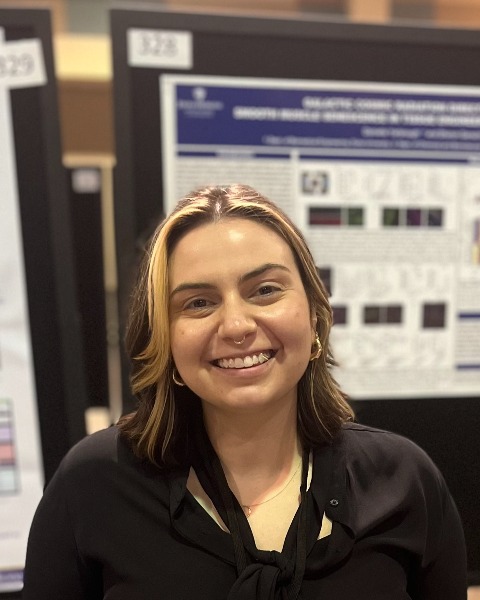Cardiovascular Engineering
Vascular Engineering & Hemocompatibility
Radiation-Induced Senescence in Stem Cell-Derived Smooth Muscle Cells Leads to Dysfunction in Tissue-Engineered Small Artery
Friday, October 25, 2024
3:00 PM - 3:15 PM EST
Location: Room 328

Danielle Yarbrough
PhD Student
Johns Hopkins University
Durham, North Carolina, United States- SG
Sharon Gerecht, PhD
Professor
Duke University, United States
Presenting Author(s)
Primary Investigator(s)
Introduction: Individuals exposed to repeated or chronic ionizing radiation, including cancer survivors, radiological workers, astronauts, and survivors of radioactive weapons, have been reported to experience significantly higher rates of cardiovascular disease (CVD) or fatal cardiovascular events than the general population[1,2]. While traditional culture methods and animal models have established a new understanding of the effects of radiation on the vasculature, tissue engineering models provide unparalleled opportunities to link cellular mechanisms to systemic damage and potential methods for preventing CVD progression. Additionally, most studies investigating radiation-induced CVD focus on endothelial cell (EC) radiation response as the sole driver of disease progression[3]. Thus, incorporating vascular smooth muscle cells (SMCs) in an in vitro tissue model can close gaps in our understanding of how SMCs directly contribute to early-stage radiation-induced CVDs such as fibrosis or coronary artery disease[4]. Our 3D tissue-engineered small artery (TESA) system applies these techniques to study direct radiation damage in SMCs through the concurrent use of an SMC-only monoculture model that is compared to a co-culture model with incorporated ECs. Additionally, our use of isogenic cells derived from human induced pluripotent stem cells (hiPSCs) results in a versatile disease modeling system with potential utility in personalized medicine. Using this system, we isolate the role that SMCs may play in the early progression of radiation-induced CVDs independently from EC-SMC crosstalk. Importantly, this model connects molecular changes in human cells to clinically indicated tissue-level pathology, making it a useful tool for therapeutic screening and future preclinical trials.
Materials and
Methods: Our TESA model is cultured either in a monoculture composed of a multilayer of hiPSC-derived SMCs (iSMCs) wrapped around a biodegradable electrospun fibrin scaffold or as a co-culture model with the iSMCs plus a hiPSC-derived EC (iEC) monolayer lining the lumen of the tubular fibrin scaffold. The TESAs are cannulated onto hollow needles in a bioreactor through which pulsatile luminal flow is applied at a maximum/minimum internal pressure of 75/30 mmHg to condition SMCs to circumferential strain. After conditioning, bioreactors are subjected to 0.1, 0.25, or 0.5 Gray of gamma or simulated Galactic Cosmic Radiation (GCR-sim), and then tissues are cultured for up to 8 days after irradiation. After exposure, tissue function is measured via mechanical properties (elastic modulus and tensile strength) and agonist-induced vasoconstriction. Immunofluorescence (IF) staining is used to quantify proliferation (Ki67), oxidative stress markers (CellROX), DNA damage markers (yH2AX), senescence markers (p21 and p16), and various contractile and extracellular matrix (ECM) proteins. Transcriptome dysregulation is evaluated with bulk RNA sequencing of harvested tissue, and pertinent upregulated disease pathways and related genes are identified via Gene Ontology (GO) analysis followed by Kyoto Encyclopedia of Genes and Genomes (KEGG) pathway analysis. Key dysregulated genes along the identified pathways are confirmed via RT-qPCR, and translated protein expression from these genes is quantified via Western Blot. Radial tensile testing is conducted at a steady velocity until failure on controls and irradiated TESA sections to evaluate tissue elasticity, tensile strength, and strain at failure.
Results, Conclusions, and Discussions: In our TESA model, radial tensile testing revealed that cellularized constructs had significantly decreased elastic moduli values compared to fibrin-only scaffolds, indicating that iSMCs had a significant effect on increasing TESA elasticity toward biological relevance (Fig 1A). Furthermore, iSMCs expressed mature contractile and ECM proteins (smooth muscle myosin heavy chain, collagen 1, and elastin) in an anatomically accurate manner (Fig. 1B). In irradiated TESAs, proliferation decreased significantly (Fig. 1C) and senescence marker expression increased slightly (Fig. 1D), but this phenotypic change did not lead to significant changes in fibrillar ECM (Fig. 1E). To investigate whole transcriptome changes, bulk RNA sequencing with GO and KEGG analyses were completed for irradiated (50 cGy GCR-sim) or control iSMC-only TESAs. At 24 hours post-irradiation, KEGG pathways for MAPK signaling and cellular senescence were upregulated (Fig. 1H), while GO terms for ECM organization and non-fibrillar ECM assembly components were interestingly downregulated (Fig. 1F). Conversely, at 8 days post-irradiation, most downregulated GO terms were involved in DNA replication and cell cycle transition, indicating potential onset of senescence (Fig. 1G). Based on the enrichment analysis results, we found specific upregulated factors associated with the Senescence-Associated Secretory Phenotype (SASP), while ECM stabilizing and organizing factors were downregulated (Fig. 1I). Tensile testing for TESA tissue-level characteristics was conducted, and irradiated TESAs displayed no significant changes in overall elasticity compared to controls but failed at a lesser strain value at 8 days post-irradiation, indicating potential onset of vessel weakness (Fig. 1J). By linking RNA sequencing analysis to tissue dysfunction in our in vitro model, we propose that the radiation-induced SASP and resultant non-fibrillar ECM disorganization in iSMCs leads directly to weakened arterial walls over time (Fig. 1K). Current work is focused on further characterizing the SASP in our tissues and the specific molecular pathway(s) inducing it and then testing a treatment to mitigate radiation-induced damage. In summary, we use our TESA model to identify a novel mechanism of radiation-induced human vascular damage, and we then assess molecular and functional response to clinically relevant radioprotective treatment.
Acknowledgements (Optional):
References: 1. Delp et al., (2016) Sci Rep, 6: 29901. ; 2. Darby et al., (2013) N Engl J Med, 368: 987-998. ; 3. Venkatesulu et al., (2018) J Am Coll Cardiol: Bas Trans Science, 3(4): 563-572. ; 4. Yang et al., (2021) Front Cardiovasc Med, 8: 652761.
This work is funded by the Translational Research Institute for Space Health and the National Science Foundation Graduate Research Fellowship Program. Thanks to Marcos Negrete and Katherine Tang for assistance in sample preparation and data collection.
